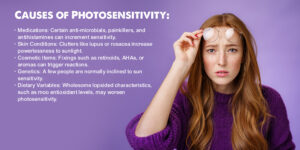Understanding Photosensitivity: How It Influences Skin and Ways to Oversee It
Photosensitivity is a condition where the skin gets to be excessively delicate to daylight or manufactured bright (UV) beams. This response can lead to skin bothering, redness, rashes, or indeed extreme burns, depending on the escalated of presentation and person affectability. Whereas photosensitivity can posture challenges, it moreover offers an opportunity to move forward skin wellbeing by tending to basic causes and receiving preventive measures.
In this article, we’ll dig into the causes, impacts, administration techniques, and benefits of tending to photosensitivity for way better skin health.
What Is Photosensitivity?
Photosensitivity happens when the skin responds strangely to UV light due to certain inner or outside variables. Common side effects include:
- Redness and inflammation.
- Blistering or peeling.
- Itchy or stinging sensations.
- Hyperpigmentation or uneven skin tone.
Causes of Photosensitivity
- Medications: Certain anti-microbials, painkillers, and antihistamines can increment sensitivity.
- Skin Conditions: Clutters like lupus or rosacea increase powerlessness to sunlight.
- Cosmetic Items: Fixings such as retinoids, AHAs, or aromas can trigger reactions.
- Genetics: A few people are normally inclined to sun sensitivity.
- Dietary Variables: Wholesome lopsided characteristics, such as moo antioxidant levels, may worsen photosensitivity.
How Photosensitivity Influences the Skin
- Short-Term Effects
- Sunburns: Indeed negligible introduction can cause serious burns.
- Rashes: Little bumps or irritated patches may develop.
- Long-Term Effects
- Skin Maturing: Quickened improvement of fine lines and wrinkles due to UV damage.
- Pigmentation Issues: Dull spots or patches caused by inflammation.
- Increased Cancer Chance: Persistent UV introduction may increment the hazard of skin cancers like melanoma.
How to Bargain With Photosensitivity
Managing photosensitivity includes a combination of preventive care, way of life changes, and focused on treatments.
- Embrace Sun Assurance Habits
- Use Sunscreen: Select for broad-spectrum SPF 30 or higher, reapplying each two hours.
- Wear Defensive Clothing: Long sleeves, wide-brimmed caps, and UV-blocking shades are essential.
- Limit Sun Introduction: Maintain a strategic distance from crest daylight hours (10 a.m. to 4 p.m.).
- Alter Skincare Routine
- Choose Tender Items: Dodge cruel exfoliants, retinoids, or scents amid flare-ups.
- Hydrate Skin: Utilize moisturizers with calming fixings like aloe vera or ceramides.
- Patch-Test Unused Items: Guarantee they don’t chafe delicate skin.
- Address Fundamental Causes
- Review Solutions: Counsel your specialist if endorsed drugs are causing sensitivity.
- Improve Nourishment: Incorporate cancer prevention agents like vitamins C, E, and beta-carotene in your count calories to reinforce skin defenses.
- Treat Therapeutic Conditions: Work with a dermatologist to oversee skin disarranges like rosacea or eczema.
- Domestic Cures for Prompt Relief
- Cold Compress: Diminishes redness and relieves aggravated skin.
- Oatmeal Showers: Calms irritation and moisturizes the skin.
- Aloe Vera Gel: Offers characteristic cooling and recuperating properties.

Basic Wellbeing Benefits of Overseeing Photosensitivity
Addressing photosensitivity can surrender noteworthy benefits for by and large skin health:
- Progressed Skin Tone and Texture
- Reducing presentation to UV harm makes a difference keep up an indeed complexion and avoids pigmentation issues.
- Slower Skin Aging
- Preventive care minimizes wrinkles, fine lines, and listing caused by sun damage.
- Upgraded Comfort
- Managing indications like tingling and aggravation moves forward day by day life.
- Diminished Skin Cancer Risk
- Protecting against UV presentation essentially brings down the chance of creating genuine skin conditions.
Diet and Way of life Tips to Bolster Photosensitivity Management
- Antioxidant-Rich Foods
- Combat free radicals caused by UV exposure.
- Examples: Berries, spinach, nuts, and green tea.
- Omega-3 Greasy Acids
- Reduce aggravation and advance skin healing.
- Examples: Salmon, flaxseeds, and walnuts.
- Satisfactory Hydration
- Keeps skin supple and minimizes sensitivity.
- Customary Exercise
- Boosts blood stream, guaranteeing supplements reach the skin.
How Overseeing Photosensitivity Benefits the Whole Body
While photosensitivity basically influences the skin, its administration has broader wellbeing benefits:
- Better Insusceptibility: Sun security diminishes systemic inflammation.
- Reduced Push: Legitimate care minimizes the uneasiness related with flare-ups.
- Holistic Wellness: Progressed skin wellbeing frequently interprets to expanded certainty and generally well-being.
Conclusion
Photosensitivity may posture challenges, but with the right approach, it is reasonable. By prioritizing sun security, embracing a adjusted count calories, and making careful skincare choices, you can minimize its impacts and appreciate more advantageous skin. Taking these steps not as it were shields against quick side effects but too improves long-term skin essentialness, clearing out you with brilliant, strong skin for a long time to come.



